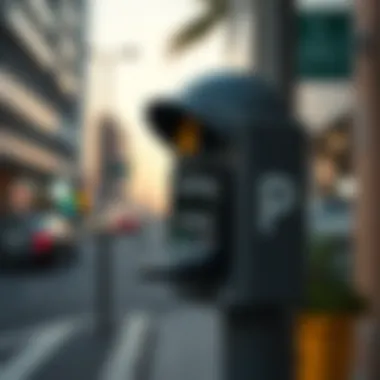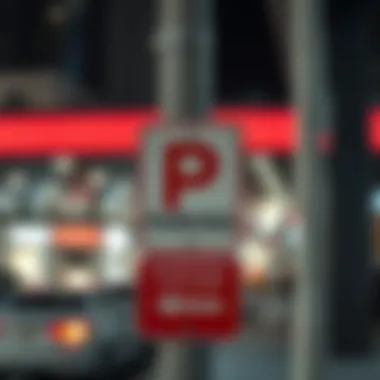Understanding Paid Parking in Dubai: A Complete Guide


Intro
Dubai, often seen as an oasis of luxury in the desert, boasts a paid parking system that is both complex and essential. It’s a bustling city where space comes at a premium and the influx of visitors and residents alike has necessitated the establishment of a structured parking framework. Understanding how parking time works in Dubai can save you time, avoid fines, and help you navigate the urban landscape effectively.
In this article, we will break down the nuances of paid parking, discussing its regulations, available payment options, the different zones, and the common hurdles users face. This isn’t just a handy guide; it’s a deep dive into the mechanics of parking in one of the world’s most vibrant cities. Knowing the ins and outs of this system can make a world of difference for both casual visitors and long-term residents.
So, let’s roll up our sleeves and get into the nitty-gritty of this vital urban system. Each section will shed light on specific aspects, aiming to equip you with essential knowledge for a smooth parking experience.
Market Trends and Analysis
Current Market Conditions
Dubai's paid parking environment has matured, mainly driven by the city's rapid urbanization and the need for an efficient system. The implementation of various types of parking zones, differentiated pricing, and clear regulations are now standard practice. As of late 2023, the city features several parking area classifications, which regulate not only fees but also time limitations.
Space in prime locations like Downtown Dubai or near the Burj Khalifa can command higher rates compared to suburban areas. Visitors often find themselves scrambling to understand the intricate signage, which outlines the parking fees and time limits.
Future Predictions and Growth Areas
Looking forward, several trends indicate that the paid parking landscape in Dubai is likely to evolve further.
- Increased Use of Mobile Payment: With the rise of technology, more users are turning to mobile apps for their parking needs. This shift could see the intro of more sophisticated payment systems that streamline the user experience, making it more convenient for everyone.
- Sustainability Initiatives: There is a possibility of introducing eco-friendly parking options—like discounts for electric vehicles or dedicated spaces for carpooling.
- Smart Solutions: The city may integrate smart parking technologies such as sensors and real-time data sharing to optimize space and assist users in locating available spots quickly.
As these trends unfold, users of paid parking in Dubai will need to stay abreast of changes and adapt accordingly.
Overview of the Parking System in Dubai
Navigating the parking landscape in Dubai can be something of a chore for both residents and visitors. With its rapid urbanization and a surge in population over recent years, the city has implemented a paid parking system that must be understood for effective urban mobility. Understanding how this system works is essential, not just for conveniently finding a spot but also for optimizing time and minimizing potential fines.
The paid parking system provides a structured approach to managing city space, leading to numerous benefits for both the authorities and users. For one, it helps alleviate congestion that often plagues busy districts. Moreover, the system generates much-needed revenue for the city, which can be funneled back into infrastructure development and maintenance.
In essence, discerning the layout and operational nuances of this parking system can lead to a less stressful experience. By understanding what the various zones entail and the regulations that govern them, stakeholders such as real estate agents, investors, and expatriates can better navigate this aspect of urban life. Learning to work within this framework allows one to engage more with the city, whether for business or leisure.
Definition of Paid Parking
Paid parking refers to the arrangement in which drivers must pay a fee to park their vehicles in designated areas. These zones are typically managed by the city or private entities, aiming to regulate the use of public parking spaces. The fees collected serve multiple purposes, including funding city services, maintaining parking infrastructure, and encouraging the turnover of parking spots to facilitate access to busy areas.
The implementation of this system can vary from street to street, with some locations charging by the hour, while others may have flat rates or offer permits for longer durations. The regulations surrounding these fees often change, so it's wise for users to stay in the loop to avoid unwelcome surprises.
Historical Development of Paid Parking in Dubai
The evolution of the paid parking system in Dubai is a tale of adaptation to the shifting urban environment. Initially, parking in the city was a mere afterthought. As the population swelled due to an influx of expatriates and tourists, the demand for parking spaces became unsustainable, prompting the authorities to take action.
In the early 2000s, paid parking initiatives began emerging, primarily in commercial districts. These measures were introduced to regulate the excessive use of available spaces and to enhance the city’s overall operational efficiency. Over time, the system was expanded to other key areas, with technological advancements making it easier for both operators and drivers. Nowadays, mobile applications facilitate payments, making the process more seamless and user-friendly.
Today, Dubai stands as a model for urban parking solutions in the Middle East, showcasing how smart urban planning and technology can align to address the pressing challenges associated with urban growth.
Types of Paid Parking Areas
The paid parking landscape in Dubai offers diverse and strategically positioned zones that cater to the needs of residents and visitors alike. Recognizing the various types of paid parking areas is crucial; these zones significantly influence where and how individuals choose to park their vehicles. The structure not only alleviates congestion but also ensures that parking spaces are utilized efficiently, benefitting both the users and the urban environment.
On-Street Parking Zones
On-street parking areas play a vital role in urban mobility. Situating these parking spaces right beside streets and avenues not only facilitates quick access to shops and offices but also maximizes efficient land use. Residents and tourists can park within walking distance of key attractions and facilities, elevating the overall experience.
- Convenience: Available in busy districts, on-street parking provides instant access to shops, restaurants, and business centers.
- Real-Time Pricing: Many zones utilize dynamic pricing based on demand, encouraging turnover of parking spaces, which can lead to reduced congestion.
- Designated Areas: Clearly marked zones dictate where vehicles may park, promoting organized use of space and reducing the chances of illegal parking, which can incur fines.
This structure is tailored for both short stays and longer visits, making it a flexible solution for diverse parking needs.


Off-Street Parking Facilities
Unlike their on-street counterparts, off-street parking facilities often include large parking lots and garages. These areas are particularly useful in high-density regions where on-street parking is limited or temporarily unavailable due to construction or events.
- Enhanced Capacity: Off-street facilities frequently offer more parking spots than what street-side zones can accommodate. This can be particularly beneficial during peak shopping seasons or during major events.
- Security Measures: Many off-street options come equipped with surveillance cameras and staff presence, which can provide peace of mind for vehicle owners.
- Payment Flexibility: Various payment options are available. Some facilities also allow pre-booking, ensuring a space is reserved in advance.
Such arrangements often cater to long-term parking needs as well, making them an excellent choice for business travelers or those jetting off on vacations.
Luxury and VIP Parking Options
Dubai's luxurious persona is mirrored in its high-end parking solutions. Luxury and VIP parking areas are designed not just for convenience but also for comfort and prestige. These exclusive zones service affluent residents and high-profile visitors who expect world-class amenities.
- Prime Locations: Often located near upscale destinations like five-star hotels, premium shopping malls, or elite entertainment venues, ensuring high accessibility.
- Enhanced Services: These facilities might include valet services, car cleaning, and even concierge services that extend beyond simple parking.
- Exclusive Access: Certain areas may be accessible only via memberships or reservations, emphasizing an elite experience.
The luxurious touch ensures that parking is not a mere functional aspect but an integral part of the overall high-end experience of life in Dubai.
"The evolution of paid parking in urban settings is not just about space; it's about delivering a tailored experience that suits the demands of modern users."
Identifying the kinds of paid parking areas lays the groundwork for understanding the operational aspects, regulations, and overall impact of parking systems in Dubai. Each type serves its purpose, shaping the urban landscape while addressing the challenges of a growing population and increasing vehicular demands.
Parking Time Regulations
Parking time regulations are a crucial aspect of navigating Dubai's paid parking system. They not only dictate when and how long vehicles can occupy designated parking spaces but also influence traffic flow and urban planning within the bustling city. Understanding these regulations helps residents, visitors, and businesses alike to avoid hefty fines and ensures a smoother experience when searching for parking.
Operational Hours of Paid Parking
Operational hours of paid parking zones across Dubai can vary significantly from one area to another. Generally, paid parking operates from 8 AM to 10 PM, but some spots may have different hours, including weekends and holidays. This differentiation is not arbitrary; it caters to the needs of both daytime workers and evening visitors.
Many areas, such as those in the business districts, see high traffic during the day and require stringent enforcement of parking regulations to optimize space utilization. Conversely, residential areas may have more lenient hours, allowing for evening parking without charge. Knowing these hours can save drivers from unnecessary fines.
Moreover, it's worth mentioning that special events or seasonal changes might temporarily alter these hours. For a more detailed and updated schedule, drivers can consult resources such as RTA Dubai for the latest information.
Maximum Parking Duration Limits
When parking in Dubai, it’s essential to be aware of the maximum duration allowed at various parking zones. These limits can differ based on location and parking type. On-street parking, for instance, typically allows a maximum of 4 hours, while off-street facilities can sometimes stretch this limit.
Such regulations serve several purposes:
- Promote turnover: Ensures that multiple drivers can benefit from available parking spaces within busy areas.
- Aid in planning: Helps local authorities manage traffic flow effectively.
- Reduce congestion: Addresses the overflow of parked vehicles obstructing roads.
For example, parking in tourist-heavy zones tends to have stricter time limits to accommodate the high influx of visitors, ensuring that more people can access local attractions seamlessly. Those who exceed the prescribed time risk more than just an inconvenience; hefty fines may follow, adding to the importance of awareness regarding these duration limits.
As parking rules can be complex and sometimes not well understood, drivers are encouraged to take extra care to familiarize themselves with specific signage or location-based restrictions. By doing so, visitors and residents can sidestep unnecessary penalties and have a more enjoyable experience exploring the city.
In summary, understanding operational hours and maximum duration limits is vital to navigating Dubai's paid parking system. It empowers users to make informed decisions, reducing stress and potential fines while promoting functional urban mobility.
Payment Methods for Paid Parking
The world of paid parking in Dubai is shifting rapidly, largely due to advancements in technology and changing user expectations. Understanding the various payment methods available to motorists not only enhances convenience but also streamlines their day-to-day experiences in a bustling city known for its busy roads and high demand for parking. This section will explore how different payment options aid users, the pros and cons of each, and how these methods are shaping the future of urban mobility in Dubai.
Mobile Payment Applications
In the age of smartphones, mobile payment applications have emerged as game-changers for parking in Dubai. Applications such as RTA's Dubai app or Parking App allow users to pay for parking swiftly and efficiently, cutting down the hassle of fumbling for change or searching for a working meter.
- Convenience: Users can pay for parking from the comfort of their vehicle, ensuring they can secure a spot without lengthy delays.
- User Interface: These apps are typically user-friendly, providing options to extend parking duration, view previous transactions, and receive notifications about parking expiry.
- Promotions and Offers: Many applications come with added features like discounts for frequent users, loyalty programs, and integrated maps to navigate towards available parking spaces.
However, depending solely on mobile apps can lead to some drawbacks, like battery dependency and occasional connectivity issues. Moreover, new users might face challenges signing up and navigating app functionalities.


Parking Meters and Machines
Despite the surge in mobile payments, traditional parking meters and machines are still a reliable option for many drivers. Found at almost every street and parking facility, these machines cater to users who prefer physical transactions.
- Accessibility: They are widespread, allowing easy access no matter where one parks. Visitors unfamiliar with local applications can easily figure them out.
- Instant Transaction: Paying cash can sometimes be quicker for folks who prefer immediate results over accessing their mobile devices.
- Simple Design: Many machines now include clearly marked instructions, reducing the chances of misunderstanding during payment.
That said, these machines can also present some issues, like malfunctioning during peak hours, leading to longer waits. The reliance on cash, especially in a increasingly cashless society, may require some adaptation for users.
Pre-Paid Parking Cards
Pre-paid parking cards have been around for a while and are becoming increasingly relevant for frequent city-goers. These cards, which can be loaded with a specific amount of credit, offer a flexible way to manage parking expenses without the need for daily cash or app payments.
- Budget Control: Users can manage their parking budget effectively, as they can only load a limited amount of money onto the card.
- Speed: Tapping a card at entry or payment points can speed up the process significantly, ideal for busy professionals or residents on the go.
- Longer Validity: Many of these cards come with extended validity periods, reducing the urgency to constantly replenish parking funds.
However, acquiring and loading funds into these cards can sometimes pose an inconvenience, especially for travelers who might not have the time or opportunity to maintain their balance.
As Dubai continues to evolve, embracing new technologies and user preferences is crucial. Parking methods will reflect the cities’ aspirations towards smart urban mobility.
Understanding these payment methods not only enables users to navigate the paid parking landscape better but also highlights a broader trend in how urban centers manage their parking systems. Whether opting for the modern take of mobile apps or the dependable familiarity of traditional machines, motorists in Dubai have various options tailored to their needs.
Enforcement of Parking Regulations
Enforcement of parking regulations plays a crucial role in maintaining order and functionality within Dubai's vibrant urban landscape. The paid parking system is designed not just for revenue generation, but also to manage vehicle parking effectively, ensuring spaces are available for those who need them. By understanding how enforcement is conducted, residents and visitors alike can navigate the parking system more confidently, minimizing the risk of fines and maximizing their convenience.
Roles of Parking Attendants
Parking attendants occupy a pivotal position within the paid parking structure. Their responsibilities extend beyond mere supervision; they are the frontline figures ensuring compliance with parking regulations. Attendants monitor designated areas to ensure vehicles are parked properly and charges are paid, addressing violations swiftly to maintain efficiency and fairness.
- Assisting drivers: They often help users understand where and how to park, pointing out payment methods and time limits.
- Issuing tickets: When regulations are violated, attendants are authorized to issue fines, which can be a deterrent to careless parking behavior.
- Keeping order: Their presence not only reinforces rules but also contributes to a sense of security, making it easier for individuals to park without worry.
Use of Technology in Enforcement
As Dubai evolves into a tech-savvy metropolis, so too does its approach to parking enforcement. Innovative technologies are employed to streamline monitoring and ensure compliance among drivers.
- Surveillance Cameras: Many paid parking zones are equipped with high-tech cameras that automatically detect parking violations, helping to issue fines electronically. This level of monitoring greatly reduces the manual labor required for enforcement.
- Mobile Applications: Users can receive notifications about their parking status directly on their smartphones, reducing the chance of forgetting payment deadlines. Furthermore, attendants can access real-time data about available parking spaces, enhancing their ability to manage areas.
Technology not only improves efficiency in monitoring but also allows for a more user-friendly experience, marrying convenience with compliance.
- Data Analytics: Authorities can analyze parking patterns and demand trends, helping in urban planning and management of parking facilities to better meet community needs.
Through these roles and technological advancements, the enforcement of parking regulations in Dubai serves as a critical pillar in the functionality and longevity of the urban parking system.
Impact of Paid Parking on Traffic and Urban Planning
The advent of paid parking in Dubai has far-reaching implications, not only for the regulation of vehicular space but also for broader traffic dynamics and urban development. As the population of Dubai continues to rise, understanding the impact of paid parking is paramount. It serves as a mechanism for controlling the congestion that frequently plagues urban areas. Moreover, this system predicates changes in commuting behaviors, ultimately swaying urban planning decisions, and infrastructure developments.
A key aspect of paid parking is its ability to manage limited space more effectively. When drivers must pay for parking, they are more likely to consider their need for a vehicle in busy urban environments. The resultant reduction in the number of active vehicles contributes to less congestion on the roads. This not only enhances the driving experience but also aligns with Dubai's vision to promote a more sustainable lifestyle. With a robust public transport system already in place, paid parking effectively nudges individuals toward alternative commuting options.
Mitigating Traffic Congestion
In a city as bustling as Dubai, traffic congestion can become an everyday struggle. Paid parking, when implemented thoughtfully, offers a solution to this persistent issue. By charging for parking, the city incentivizes short-term use of spaces. For instance, users who know they will be charged for parking are more likely to keep their visits brief, which in turn opens up spaces for others. This constant turnover is beneficial in crowded areas, allowing a quick rotation of vehicles and keeping the traffic flowing smoothly.
Moreover, when streets are priced based on demand, customers can find parking more easily. Implementing a pricing strategy that fluctuates according to peak hours can ensure that spaces are available when needed most. The city of Dubai has incorporated a blend of parking fees that vary throughout the day. Such a model has effectively reduced the bottleneck phenomenon, where too many vehicles congregate in popular areas during peak times. As a result, the impacts of delayed arrivals and frustrated drivers have decreased significantly.
Encouraging Public Transport Usage
Paid parking doesn't merely regulate the use of personal vehicles; it also propels the adoption of public transport. With costs associated with parking, commuters may begin to weigh their options more carefully. Utilizing the Metro or public buses often becomes a more appealing alternative. Dubai boasts an elaborate public transport network that is both efficient and extensive. As more individuals turn to these options, traffic on the major roads decreases, leading to lower emissions and reduced wear on infrastructure.


For urban planners, this shift toward public transport means that there can be a focus on enhancing such facilities rather than expending resources on automobile infrastructure. The funds generated from paid parking can be reinvested into improving the public transport infrastructure, thus creating a virtuous cycle.
Challenges Faced by Users
The intricate web of the paid parking system in Dubai presents a unique set of challenges for its users. Understanding these barriers is crucial for residents, visitors, and those engaged in the real estate market. This section explores common issues that arise in everyday parking experiences, emphasizing their significance on user satisfaction and urban mobility.
Common Issues and Complaints
Navigating the parking landscape can often feel like a labyrinth; not all paths are straightforward. Residents and visitors alike have voiced a multitude of complaints.
- Inconsistent Availability: Users frequently find themselves on the hunt for out-of-reach parking spots, especially in high-demand areas like downtown or near popular malls. A person might circle a block multiple times before finding a spot, leading to frustration.
- Insufficient Signage: In some cases, the lack of clear and visible signage can make it difficult for drivers to identify what areas require payment, thus leading to unexpected fines. A missing sign can transform a simple outing into a costly affair.
- Enforcement Gaps: While responsible monitoring by parking attendants is essential, lapses in enforcement can occur. This inconsistency can lead to a sense of unfairness among those who follow the rules and frequently witness others who don’t suffer any consequences.
- Technical Glitches: With many payment systems relying on technology, bugs and errors can disrupt users’ experiences. A failed payment could mean getting a ticket, even if the driver made a genuine attempt to follow the rules.
"The experience of parking in Dubai can be like a roller coaster; sometimes you're cruising smoothly, other times, you're left feeling dizzy with stress."
Discrepancies in Pricing
Pricing can often feel like a moving target. Users have raised concerns regarding disparities in parking fees, which can vary based on location, time, and even demand.
- Dynamic Pricing: Price changes based on peak hours mean users can pay vastly different rates for parking just because they arrived a few minutes earlier or later. This calculation can bewilder many, especially those on tight budgets.
- Lack of Transparency: There's also the issue of clarity. Some users find it hard to understand the pricing structure for different areas, leading to unexpected costs. A casual visitor might be dismayed to find out a seemingly reasonable spot has hidden charges.
- Comparative Costs: As the region develops and more commercial establishments surface, parking prices follow suit. For instance, a parking space near a newly opened high-end restaurant could command a hefty fee. This can alienate casual diners who aren't prepared for such expenses, causing them to look for alternative dining options.
In summary, successful navigation of Dubai's paid parking entails an understanding of both the system’s quirks and the public's pain points. Identifying and addressing these challenges can lead to a more user-friendly experience. A better grasp of these concerns also arms real estate professionals, investors, and homeowners with insights necessary for fostering a more accessible urban environment.
Future Considerations for Paid Parking
In a city as dynamic as Dubai, it's crucial to keep an eye on how the paid parking system can adapt and evolve over time. Recognizing future considerations for paid parking can significantly enhance user experience while addressing urban challenges. It involves looking at how technology is changing the landscape of parking and highlighting the need for sustainable solutions that are environmentally friendly. The goal here is to balance the needs of drivers with those of the city, ensuring enough supply while minimizing congestion and residual impacts.
Evolving Technology and Innovations
Technological advancements are reshaping everything, and parking is no exception. Smart parking systems are being increasingly adopted in Dubai. These systems utilize sensors, apps, and real-time data to streamline the parking experience. For instance, apps can show open spots, reducing the time spent looking for space, which is a win-win considering the urban heat and traffic.
Currently, there are platforms like Dubai’s RTA app which feature a map of available parking spaces. Through ongoing development, there’s even talk about integrating parking with vehicle navigation systems. It means drivers could navigate to their destination while ensuring they don’t miss available parking without any hassle.
The implementation of contactless payment methods also plays a part in the tech evolution. With mobile payment options becoming commonplace, users can complete transactions quickly. This reflects a broader shift towards digital solutions, streamlining operations and enhancing user satisfaction.
"The fusion of technology into everyday parking operations will inevitably lead to a smoother, more user-friendly experience for everyone involved."
Sustainable Parking Solutions
Sustainability has found its way into many urban discussions, including parking. As Dubai emphasizes green initiatives, integrating sustainable parking solutions can significantly contribute to the overall health of the city. This can mean installing electric vehicle charging stations alongside standard parking spots, encouraging the use of electric vehicles.
Another aspect is promoting shared spaces, where car ownership is no longer a necessity for every individual. Carpooling initiatives can lead to fewer vehicles on the road, thereby reducing parking demand and emissions. The prospect of developing more pedestrian-friendly areas and creating bicycle parking zones also helps mitigate the reliance on cars.
Combining paid parking with public transportation can bolster the shift towards sustainability. Encouraging commuters to use public transport while providing them with the option to park and ride significantly reduces congestion. This could entail discounted parking rates for users who utilize public transport during peak hours.
Considering these future avenues opens the door to smarter, more adaptable parking systems that aren't just efficient but also environmentally responsible.
Culmination and Final Thoughts
Understanding the framework of paid parking in Dubai is essential for anyone navigating its intricate urban landscape. The parking system is not merely a mechanism for collecting fees; it plays a pivotal role in mitigating traffic congestion, promoting efficient use of space, and integrating smart technology into the broader urban fabric. Grasping this system aids both residents and visitors in making informed decisions that enhance their experience in the city.
The article examined various components surrounding paid parking—such as the operational hours, payment methods, and enforcement regulations. By distilling these details, we can shed light on its relevance to urban life in Dubai. As the city continues to expand and attract international interest, efficient and well-managed parking solutions will become even more crucial. Moreover, navigating the expectations of users and balancing enforcement can lead to a more pleasant city experience.
Summarizing Key Insights
- Historical Context: Understanding the development of paid parking provides insight into how urban planning has adapted to meet the needs of a growing population.
- Types of Parking Areas: Recognizing different types of paid parking limits, like on-street versus off-street, helps users strategize their parking choices effectively.
- Payment Innovations: Familiarity with mobile apps and advanced payment methods simplifies the logistics of parking, ensuring a smooth user experience.
- Challenges Identified: Users often face common complaints that can impede their parking experience. Addressing these issues head-on can lead to improvements in service.
This summary of insights encapsulates not just what to expect in the realm of paid parking, but also how these elements interconnect to form a cohesive picture of urban management in Dubai.
Recommendations for Users
Navigating Dubai's paid parking system can be frustrating if you're not fully aware of all the ins and outs. Here are a few suggestions to help make your parking experience seamless:
- Familiarize Yourself with Operational Hours: Always check when paid parking is enforced; some areas might differ.
- Use Technology: Leverage mobile payment apps to avoid the hassle of using old-fashioned meters or machines. These apps often have real-time availability updates.
- Listen to Local Advice: Engage with the community through platforms like Reddit or Facebook groups. Locals can provide valuable insight into the best spots and potential pitfalls.
- Know the Limitations: Some areas have specific maximum duration limits for parking—be aware of these to avoid fines.
- Provide Feedback: If you face issues, report them. Continuous feedback can lead to necessary changes and improvements.
By taking these steps, you can turn what seems like a tedious process into a more manageable task. Awareness leads to empowerment, and that’s what you need while dealing with parking in a vibrant metropolis like Dubai.











